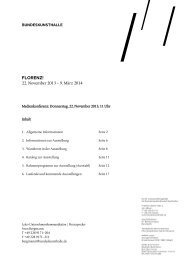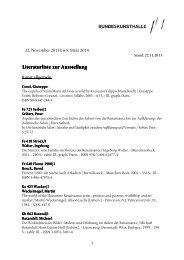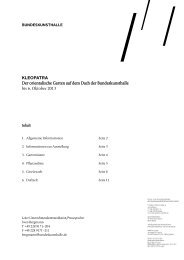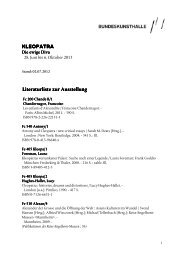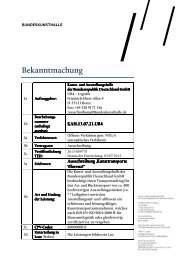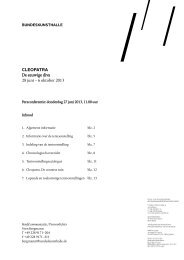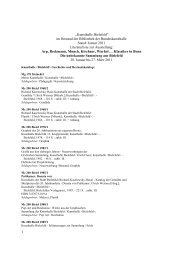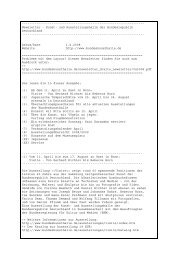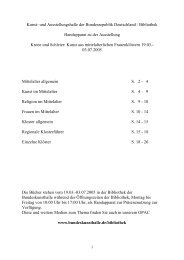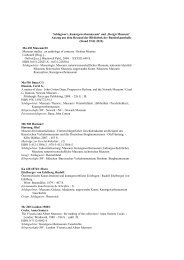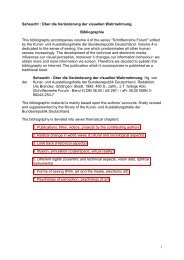Peoples through space and time Archaeology in Germany 09.05 ...
Peoples through space and time Archaeology in Germany 09.05 ...
Peoples through space and time Archaeology in Germany 09.05 ...
You also want an ePaper? Increase the reach of your titles
YUMPU automatically turns print PDFs into web optimized ePapers that Google loves.
from the mother <strong>and</strong> only changes by mutation. Through trac<strong>in</strong>g common mutations occurr<strong>in</strong>g over <strong>time</strong><br />
questions of orig<strong>in</strong> may be answered.<br />
In 1997 mitochondrial DNA was extracted for the first <strong>time</strong> from the humerus bone of the first<br />
Ne<strong>and</strong>erthal skeleton to be found. The genetic differences to humans liv<strong>in</strong>g today po<strong>in</strong>t to the fact that<br />
the Ne<strong>and</strong>erthal was not a direct ancestor.<br />
Genetic F<strong>in</strong>gerpr<strong>in</strong>ts of an Extended Family<br />
When skeletons were found <strong>in</strong> the Lichtenste<strong>in</strong> Cave near Osterode <strong>in</strong> 1980, they were thought to be the<br />
rema<strong>in</strong>s of human sacrifices from the late Bronze Age.<br />
It was not until 1992, when systematic excavations began to take place, that 38 human rema<strong>in</strong>s of both<br />
sexes <strong>and</strong> all ages were recovered, of which it was possible to analyze 21 with regard to their ‘genetic<br />
f<strong>in</strong>gerpr<strong>in</strong>t’. Fortunately, low temperatures exist<strong>in</strong>g <strong>in</strong> the cave created an excellent environment for<br />
preserv<strong>in</strong>g DNA. Because of this, it was possible to determ<strong>in</strong>e family k<strong>in</strong>ship with 99-percent certa<strong>in</strong>ty,<br />
which is the necessary st<strong>and</strong>ard for modern paternity tests, for example.<br />
As a result, it was possible to reconstruct k<strong>in</strong>ship for the first <strong>time</strong> with<strong>in</strong> a prehistoric group without<br />
any archaeological <strong>in</strong>dication of family relationships exist<strong>in</strong>g previously. The analysis proved that<br />
k<strong>in</strong>ship among the skeletal bodies is similar to what you would f<strong>in</strong>d <strong>in</strong> a graveyard of the same era,<br />
mak<strong>in</strong>g it possible to identify the cave as a place of burial.<br />
The Thermolum<strong>in</strong>escence Method<br />
Some m<strong>in</strong>erals store energy from radioactive elements <strong>and</strong> cosmic radiation. The older the m<strong>in</strong>eral, the<br />
more energy is stored <strong>in</strong> its crystal lattice. This energy is set free at temperatures over 500°C <strong>and</strong> the<br />
process of absorption beg<strong>in</strong>s aga<strong>in</strong>. For analysis, heat (over 500°C) is applied to samples so that the<br />
energy stored will be emitted <strong>in</strong> the form of light (=Thermolum<strong>in</strong>iscence). This light is measured <strong>and</strong><br />
determ<strong>in</strong>es the age of the sample. The Thermolum<strong>in</strong>iscence method is especially used to determ<strong>in</strong>e the<br />
age of samples that are 50,000 to 100,000 years old.<br />
05<br />
The Middle <strong>and</strong> Late Stone Age of Hunters, Gatherers <strong>and</strong> Fishers<br />
The Middle <strong>and</strong> Late Stone Ages together form the longest period <strong>in</strong> human history, compris<strong>in</strong>g more<br />
than a million years. Dur<strong>in</strong>g this <strong>time</strong>, hunters <strong>and</strong> gatherers were subject to <strong>in</strong>tense climatic change.<br />
Already <strong>in</strong> the 19 th century <strong>in</strong>terdiscipl<strong>in</strong>ary research was be<strong>in</strong>g carried out to determ<strong>in</strong>e the k<strong>in</strong>d of<br />
conditions under which humans lived dur<strong>in</strong>g the Ice Age. <strong>Archaeology</strong>’s ma<strong>in</strong> concern was at first to<br />
study <strong>and</strong> classify the stone tool forms found at ancient rest<strong>in</strong>g places, to assign them with<strong>in</strong> a<br />
stratigraphic-chronological order <strong>and</strong> to chronologically order this era.<br />
Excavations of the past decades have been carried out with great accuracy, allow<strong>in</strong>g a systematic<br />
analysis of Ice Age hunt<strong>in</strong>g camps. Apparently they were set up accord<strong>in</strong>g to functional criteria. Recent<br />
research has shown that prehistoric hunt<strong>in</strong>g communities were <strong>in</strong>telligently organized, even those of<br />
Homo erectus 400,000 years ago. As a result, views of our ancestors’ primitive life have begun to<br />
change. In determ<strong>in</strong><strong>in</strong>g the dates, the k<strong>in</strong>d of climate <strong>and</strong> environment that prevailed, as well as <strong>in</strong><br />
reconstruct<strong>in</strong>g ecological correlations, other related scientific discipl<strong>in</strong>es are of prime importance.<br />
The Oldest Spears <strong>in</strong> the World<br />
S<strong>in</strong>ce 1992 more Paleolithic sites are be<strong>in</strong>g excavated at the brown coal m<strong>in</strong><strong>in</strong>g works <strong>in</strong> Schön<strong>in</strong>gen,<br />
south of Helmstedt <strong>in</strong> Lower Saxony. These massive 10- to 15-meter-thick Ice Age deposits with their<br />
<strong>in</strong>terglacial layers are rich reservoirs of animal <strong>and</strong> plant rema<strong>in</strong>s. As such they offer a chance to more<br />
accurately reconstruct the climate, vegetation <strong>and</strong> environmental history of Central Europe for the <strong>time</strong><br />
rang<strong>in</strong>g from 400,000 years ago to today.<br />
Of particular importance is the discovery of a camp of wild horse hunters spread over an area of<br />
approximately 2500 m² <strong>in</strong> which thous<strong>and</strong>s of bones, fl<strong>in</strong>tstone tools <strong>and</strong> various campfire sites have<br />
been found. A major advance <strong>in</strong> research is represented by seven wood spears found <strong>in</strong> total <strong>and</strong> dated<br />
at 400,000 years old - the oldest preserved human hunt<strong>in</strong>g tools ever to have been found. In addition,<br />
the discovery at Schön<strong>in</strong>gen proves that the Central European Homo erectus was capable of produc<strong>in</strong>g<br />
effective projectile weapons <strong>and</strong> of organiz<strong>in</strong>g a systematic hunt for big game.<br />
7




